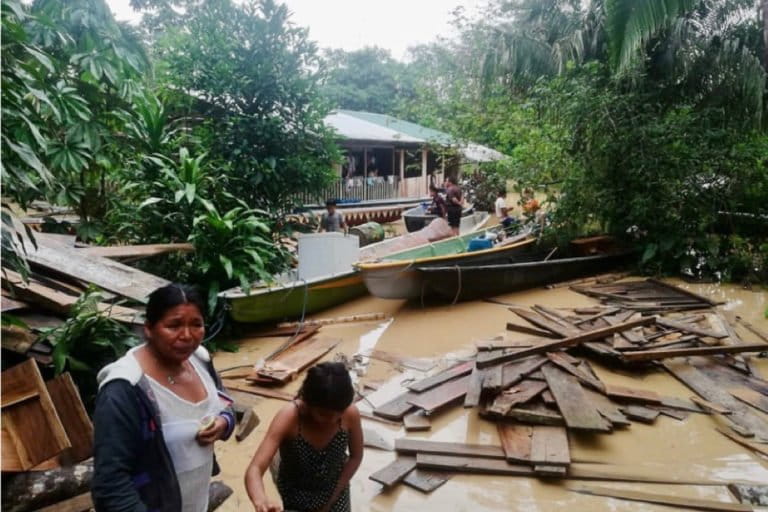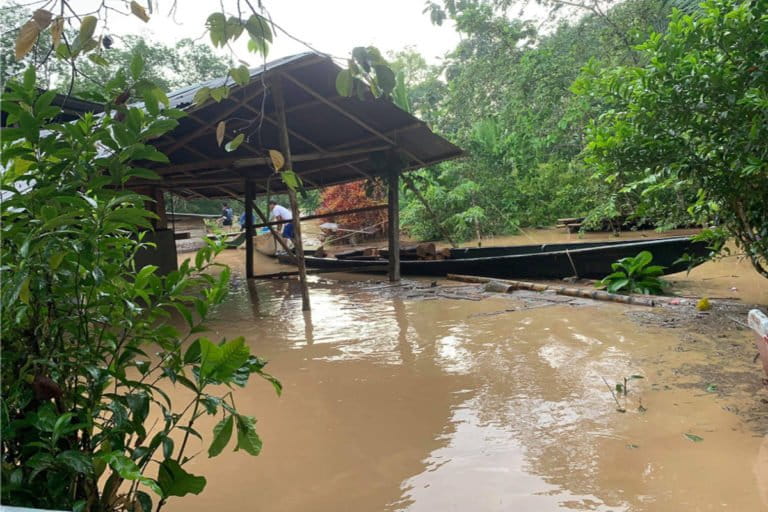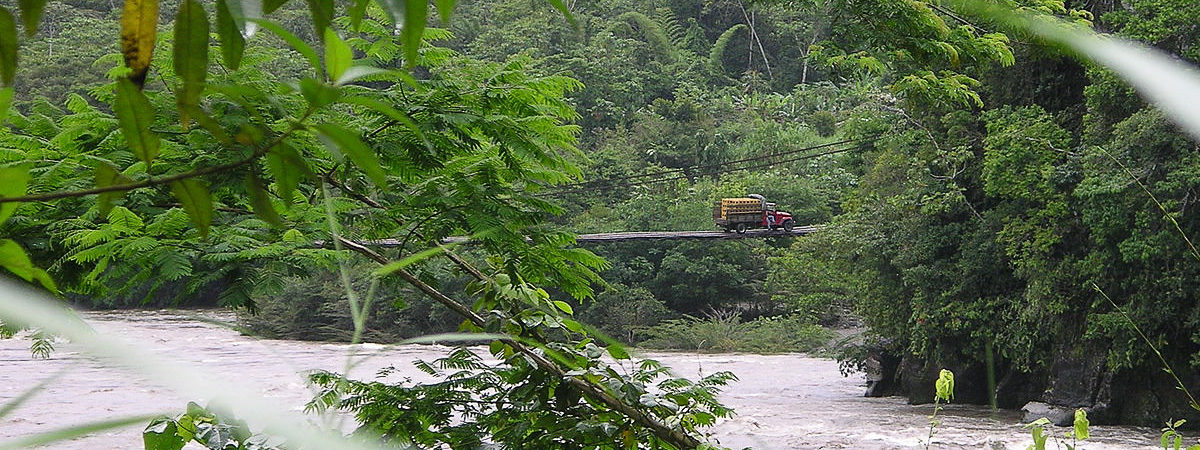- Extreme floods in the Ecuadoran Amazon have left hundreds of indigenous people homeless.
- Such events have become more frequent, partly as a result of human-driven climate change.
- These communities have little to no access to basic services, which leaves them in an extremely vulnerable situation.
- Further complicating their plight is the global COVID-19 pandemic that has now made its way into Ecuador, one of the Latin American countries hit hardest by the coronavirus so far.
Extreme flooding in the Ecuadoran Amazon has caused widespread disarray along the banks of the Bobonaza River, all amid the COVID-19 pandemic.
Over the past couple of weeks, the surging water levels have left hundreds homeless, washing away homes, schools, crops, animals and a bridge in the Sarayaku indigenous community. The floods have also affected the Pacayaku and Teresa Mama indigenous communities.
“I don’t think any one of us imagined how bad it would be,” said Helena Gualinga, an environmental and indigenous rights defender and resident of the Sarayaku community. “We’ve seen floods before, but never anything this devastating or big. This one was completely different. The river reached levels that we never actually thought possible before.”

In Helena’s community, 30 families lost their homes, and the flooding destroyed many schools near the river. As the pandemic has forced the world into a global sabbatical, shaken by an atmosphere of all-embracing uncertainty, one thing is for sure: the likely effects of climate change stop for nothing.
The virus, of course, has wreaked chaos in many hospitals. Proper equipment such as masks, ventilators and beds are in short supply, and experts fear the situation could get worse before it gets better. But in many of Ecuador’s indigenous communities, these basic resources are scarce under normal circumstances. Acquiring them now, should the disease take hold in these communities, seems all but inconceivable.

Flood in the time of coronavirus
Three days after the initial flood, Helena’s sister Nina shared images of the destruction in an Instagram post. She said she felt “devastated” and “powerless” and called on her followers to support the affected communities.
In 2018, a study published in the journal Science Advances revealed that extreme flooding events in the Amazon Basin have indeed increased in recent decades as a result of a combination of factors. One of those factors is an increase of warm, moist air — partly as a result of human-driven climate change — from the tropical Atlantic Ocean across South America toward the Pacific. Scientists call this pattern the Walker Circulation. As it has grown stronger, floods in the Amazon have become more intense and longer-lasting, putting lives and livelihoods at greater risk.
Jonathan Barichivich, the study’s lead author and an environmental scientist at the Institute of Conservation, Biodiversity and Territory at the Universidad Austral de Chile, said that flooding events have become more frequent and extreme in recent years due to the combination of anthropogenic climate change and natural variability.
“Thus, global climate change plays a large and primary role in the observed flooding,” Barichivich said in an email. “Local to regional factors such as deforestation — that remove the vegetation buffer from the land surface — also contribute to increased flooding intensity and speed by increasing the amount of surface runoff and amplifying the effect of enhanced rain intensity on river levels.”

Indigenous communities in the Amazon are often the first to feel the convergence of these effects.
“The exploitation of natural resources as if they were infinite has affected not only nature but also the collective rights and knowledge of the indigenous and non-indigenous populations of the Amazon,” said Patricia Gabriela Serrano Roca, REDD+ and finance coordinator of PROAmazonía, an initiative set up by the Ecuadoran government with the Ministries of the Environment and of Agriculture to mitigate climate change and tackle the main causes of deforestation.
As a consequence, the effects of natural disasters, such as constant landslides and floods, hit hardest poor communities like Sarayaku where the Gualingas live because they’re more vulnerable with fewer economic opportunities and limited access to the resources that might help them.
“The impacts of climate change are already being felt across the planet. Ecuador is not any different than this trend,” Serrano Roca said.
Helena Gualinga, who is 18 years old, saw her first flood when she was about 10 or 11. “My elders used to tell me that a flood came every 20 years,” she said in an interview. “The year I saw that first flood, I also saw five others. Now it’s just increasing and also the intensity. It’s not that it rains more. It’s that when it rains, it’s more intense.”
The value of Ecuador’s forests isn’t just that they serve as a buffer to more severe flooding. Vast amounts of carbon are absorbed in their biomass every year, making them important regulators of Earth’s climate. If those forests are cleared, then they switch to being a source of carbon instead of a sink. According to PROAmazonía, scientists estimate that a hectare (2.5 acres) of native forest in Ecuador can generate 400 to 600 metric tons of carbon dioxide if deforested. This figure is concerning given that, between 1990 and 2014, the country’s average annual gross deforestation rate was nearly 130,000 hectares (321,000 acres). Between 2014 and 2016, this dropped to the still-alarming figure of around 94,000 hectares (232,000 acres) per year.
The people of Sarayaku live in the center of Pastaza province, mostly along the banks of the Bobonaza River. In this part of the country, there are no roads; to get there, you must go by river or air. As a consequence, in this time of intense devastation with an urgent need for aid, these communities are extremely vulnerable.
Members of the community are starting to rebuild their homes after the last wave of flooding, but accessing supplies and support has been extremely challenging. The Confederation of Indigenous Nationalities of the Ecuadoran Amazon (CONFENIAE), the regional organization of indigenous peoples in the Ecuadoran Amazon or Oriente region, has closed all access to the rainforest, denying entry to both tourists and Ecuadoran nationals. The government declared a state of national emergency, ordering everyone to stay home unless they were buying food, medicine or going to work, making rebuilding a broken community a complicated process.

The coronavirus puts indigenous people at high risk due to the poor health service and high prevalence of disease — all made worse by the damage caused by the floods.
“We live in small houses made of trees and palms,” Helena said. “It’s a very small community, and we’re absolutely not prepared to get something like the coronavirus.”
Serrano Roca from PROAmazonía says she believes finding a way to adapt to both the floods and dramatic periods of drought over the long term is critical to securing livelihoods and protecting the Amazon forest from climate change, along with other shocks such as the current global pandemic. She says this effort should include “an analysis of the cultural and socioeconomic aspects” to ensure measures are in line with “the reality of the beneficiary communities.”
To meet the communities’ immediate needs, Helena and the rainforest protection NGO Amazon Watch set up a GoFundMe fundraising page to help provide emergency supplies to those affected; their $50,000 target has now been surpassed. More than a hundred families have now received help despite the challenge of a national curfew and closed transportation routes. Volunteers in the community came together to collect the supplies deliver them by canoe — resources that Helena said are needed now more than ever.
“To start rebuilding, I believe it will take a lot of time and a lot of resources,” she said. “A lot has been lost.”
Aimee Gabay is an intern at Mongabay and studies journalism in London. Find her on Twitter: @aimeegabay.
Banner image by André Hübner via Wikimedia Commons (CC BY-SA).
Citation:
Barichivich, J., Gloor, E., Peylin, P., Brienen, R. J. W., Schöngart, J., Espinoza, J. C., & Pattnayak, K. C. (2018). Recent intensification of Amazon flooding extremes driven by strengthened Walker circulation. Science Advances, 4(9), eaat8785. doi:10.1126/sciadv.aat8785
FEEDBACK: Use this form to send a message to the author of this post. If you want to post a public comment, you can do that at the bottom of the page.
